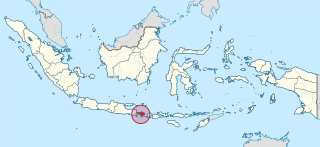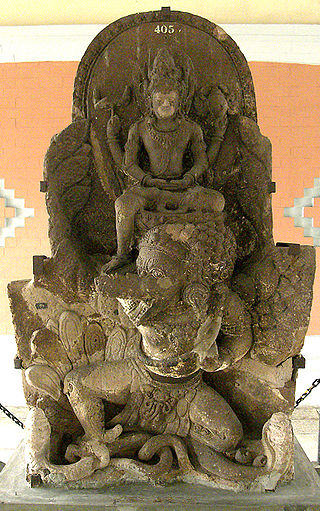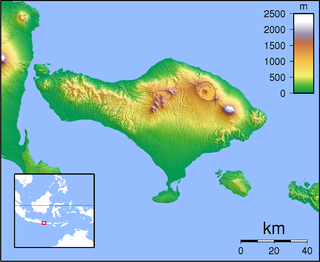Related Research Articles

Bali is a province of Indonesia and the westernmost of the Lesser Sunda Islands. East of Java and west of Lombok, the province includes the island of Bali and a few smaller offshore islands, notably Nusa Penida, Nusa Lembongan, and Nusa Ceningan to the southeast. The provincial capital, Denpasar, is the most populous city in the Lesser Sunda Islands and the second-largest, after Makassar, in Eastern Indonesia. Denpasar metropolitan area is the extended metropolitan area around Denpasar. The upland town of Ubud in Greater Denpasar is considered Bali's cultural centre. The province is Indonesia's main tourist destination, with a significant rise in tourism since the 1980s, and becoming an Indonesian area of overtourism. Tourism-related business makes up 80% of the Bali economy.

The 10th century was the period from 901 through 1000 (M) in accordance with the Julian calendar, and the last century of the 1st millennium.

Balinese Hinduism, also known in Indonesia as Agama Hindu Dharma, Agama Tirtha, Agama Air Suci or Agama Hindu Bali, is the form of Hinduism practised by the majority of the population of Bali. This is particularly associated with the Balinese people residing on the island, and represents a distinct form of Hindu worship incorporating local animism, ancestor worship or Pitru Paksha, and reverence for Buddhist saints or Bodhisattava.

Rangda is the demon queen of the Leyaks in Bali, according to traditional Balinese mythology. Terrifying to behold, the child-eating Rangda leads an army of evil witches against the leader of the forces of good — Barong. The battle between Barong and Rangda is featured in a Barong dance which represents the eternal battle between good and evil.

Hinduism is the third-largest religion in Indonesia, based on civil registration data in 2023 from Ministry of Home Affairs, is practised by about 1.68% of the total population, and almost 87% of the population in Bali. Hinduism was the dominant religion in the country before the arrival of Islam and is one of the six official religions of Indonesia today. Hinduism came to Indonesia in the 1st-century through Indian traders, sailors, scholars and priests. A syncretic fusion of pre-existing Javanese folk religion, culture and Hindu ideas, that from the 6th-century also synthesized Buddhist ideas as well, evolved as the Indonesian version of Hinduism. These ideas continued to develop during the Srivijaya and Majapahit empires. About 1400 CE, these kingdoms were introduced to Islam from coast-based Muslim traders, and thereafter Hinduism, which was previously the dominant religion in the region, mostly vanished from many of the islands of Indonesia.

Barong is a panther-like creature and character in the Balinese mythology of Bali, Indonesia. He is the king of the spirits, leader of the hosts of good, and enemy of Rangda, the demon queen and mother of all spirit guarders in the mythological traditions of Bali. The battle between Barong and Rangda is featured in the Barong dance to represent the eternal battle between good and evil.
Dharmawangsa, stylized regnal name Sri Maharaja Isyana Dharmawangsa Teguh Anantawikramottunggadewa of the Isyana dynasty, was the last Hindu raja of the Kingdom of Mataram, who reigned from 990 to 1016 CE. He is also known by his posthumous name Wijayamreta Wardhana, which means "powerful in glorious death", which refers to his fight to the death.

Airlangga, regnal name Rakai Halu Sri Lokeswara Dharmawangsa Airlangga Anantawikramottunggadewa, was the only king of the Kingdom of Kahuripan.

Gunung Kawi Temple popularly known as The Valley of The Balinese Kings is an 11th-century temple and funerary complex in Tampaksiring north east of Ubud in Bali, Indonesia., that is spread across either side of the Pakerisan river. It comprises 10 rock-cut candi (shrines) that are carved into some 7-metre-high (23 ft) sheltered niches of the sheer cliff face. These funeral monuments are thought to be dedicated to King Anak Wungsu of the Udayana dynasty and his favourite queens. On the east side there are five temples that are dedicated, according to one theory, to King Udayana, his queen Mahendradatta, and their sons Airlangga, Anak Wungsu, and Marakata. The temples on the west side are dedicated, according to the same theory, to the king's minor queens or concubines.

The History of Bali covers a period from the Paleolithic to the present, and is characterized by migrations of people and cultures from other parts of Asia. In the 16th century, the history of Bali started to be marked by Western influence with the arrival of Europeans, to become, after a long and difficult colonial period under the Dutch, an example of the preservation of traditional cultures and a key tourist destination.

Sri Kesari Warmadewa was the first king of Bali whose name is recorded in a written inscription. He was the issuing authority for four inscriptions, including the famous 914 CE inscription on the Belanjong pillar in southern Sanur.

The Warmadewa dynasty, also Varmadeva dynasty, was a regnal dynasty on the island of Bali.

The Belanjong pillar, also Blanjong pillar or Blanjong inscription, is a pillar established in 914 CE in the harbour of Belanjong, in the southern area of Sanur in Bali.
Mahendradatta, also known as Gunapriya Dharmapatni, was the queen of Bali and wife of Udayana Warmadewa, also popularly known as King Udayana from Warmadewa dynasty. She was also the mother of Javanese hero-king Airlangga. Mahendradatta and Udayana co-ruled Bali, issuing inscriptions in both their names. Her other younger sons are Marakata and Anak Wungçu.

Kahuripan was an 11th-century Javanese Hindu-Buddhist kingdom with its capital located around the estuarine of Brantas River valley in East Java. The kingdom was short-lived, only spanning the period between 1019 and 1045, and Airlangga was the only raja of the kingdom, which was built out of the rubble of the Kingdom of Mataram after the Srivijaya invasion. Airlangga later in 1045 abdicated in favour of his two sons and divided the kingdom into Janggala and Panjalu (Kadiri). The kingdom's name derived from Old Javanese term hurip with circumfix ka- -an which means "life" or "livelihood". Later in 14th to 15th century, the former kingdom was recognised as one of Majapahit's 12 provinces.

The Kingdomship of Bali was a series of Hindu-Buddhist kingdoms that once ruled some parts of the volcanic island of Bali, in Lesser Sunda Islands, Indonesia. With a history of native Balinese kingship spanning from the early 10th to early 20th centuries, Balinese kingdoms demonstrated sophisticated Balinese court culture where native elements of spirit and ancestral reverence combined with Hindu influences—adopted from India through ancient Java intermediary—flourished, enriched and shaped Balinese culture.
Sri Makutawangsa Wardhana was the Hindu king of Mataram Kingdom, in East Java, that ruled prior to 990s CE. He was the son and the successor of Queen Isyana Tunggawijaya and King Sri Lokapala. He belongs to the Isyana dynasty, established by his grandfather, Mpu Sindok that ruled Java circa the 10th century CE.
Śri Ajñadewi was a reigning queen of Bali, who flourished in 1016 CE.
Marakata Pangkaja was a Balinese king from the Warmadewa dynasty. He was the son of King Udayana and Queen Mahendradatta, a Javanese princess. His royal title was Çri Dharmawangsa Wardhana Marakata Pangkajastanottunggadewa. He ascended to the throne in 1022 CE, and probably reigned until 1049 CE. His reign coincided with the reign of his elder brother, King Airlangga, who ruled the Mataram Kingdom in Java. After he died, the next king who ruled Bali was his younger brother, King Anak Wungsu.
References
- Willard A. Hanna (2004). Bali Chronicles. Periplus, Singapore. ISBN 0-7946-0272-X.